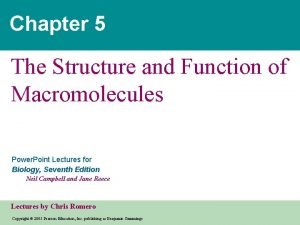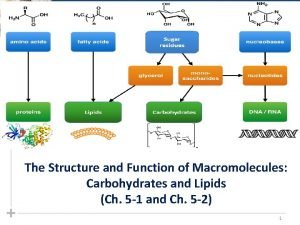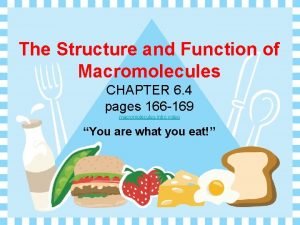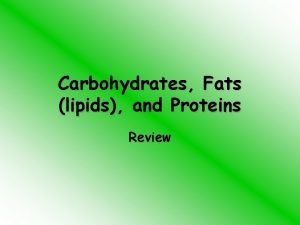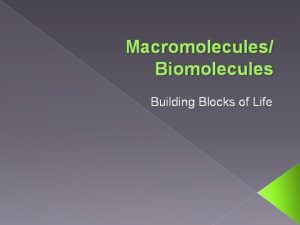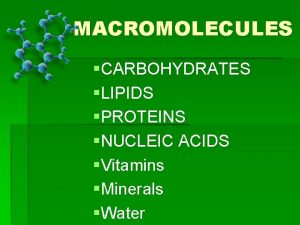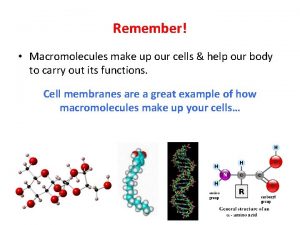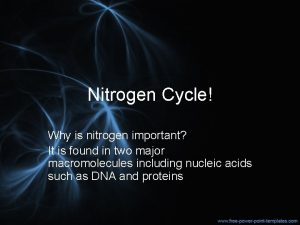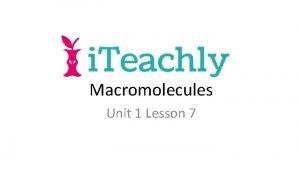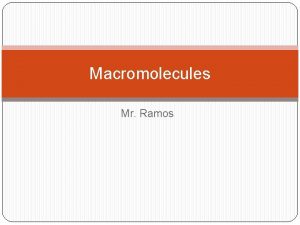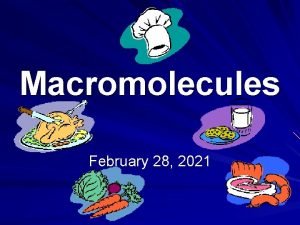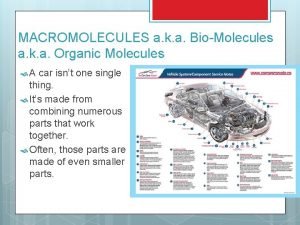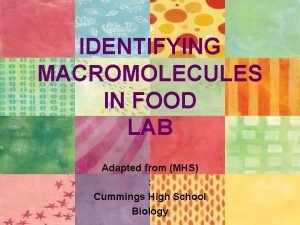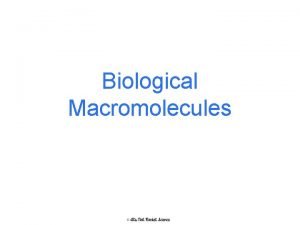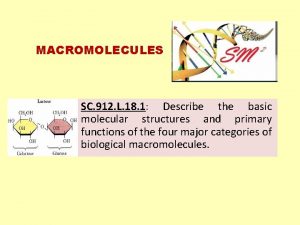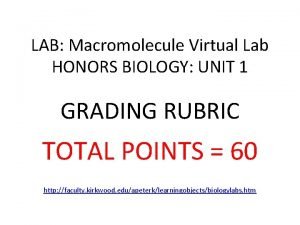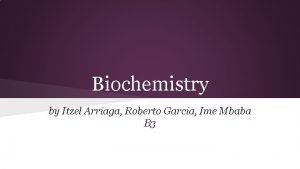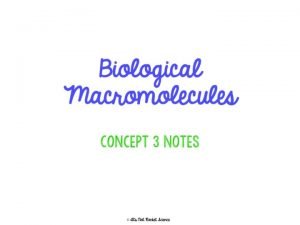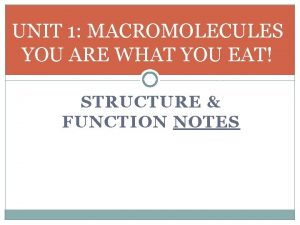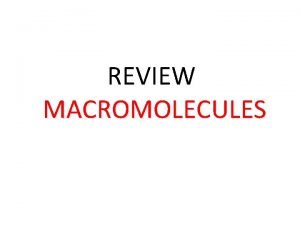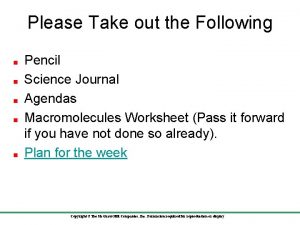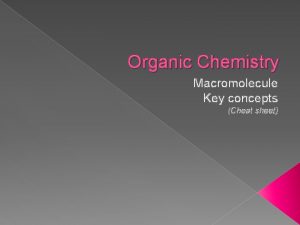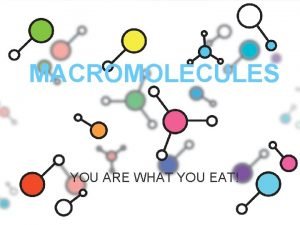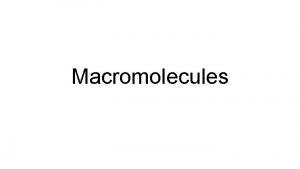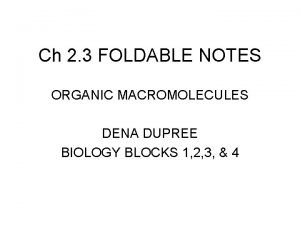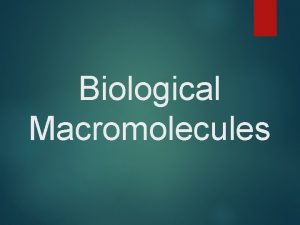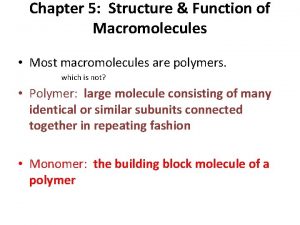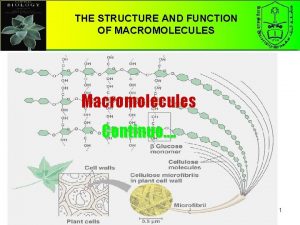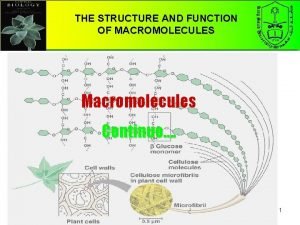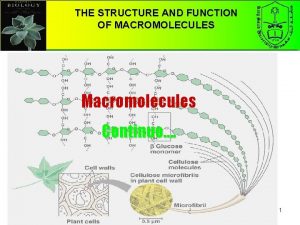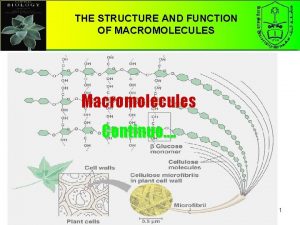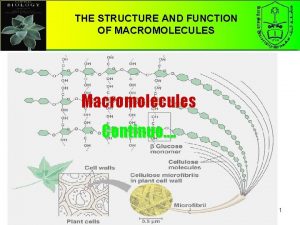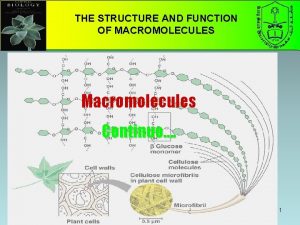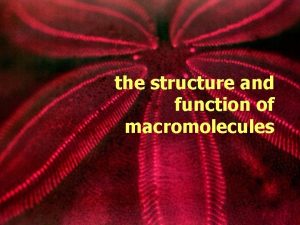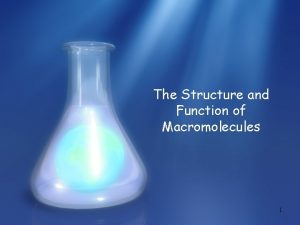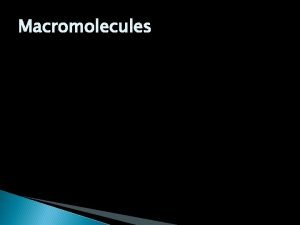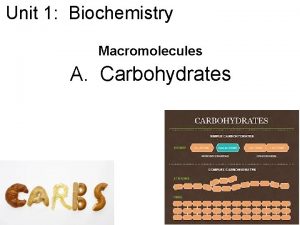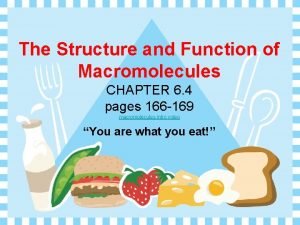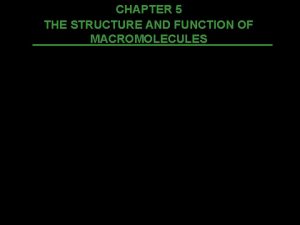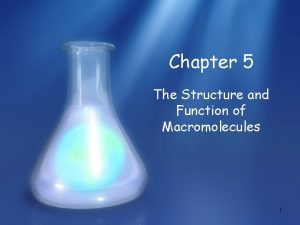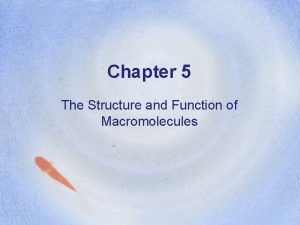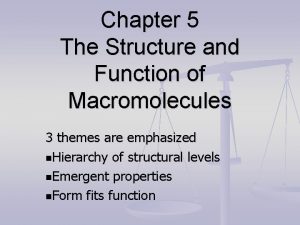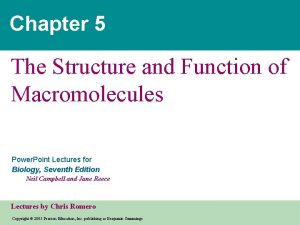THE STRUCTURE AND FUNCTION OF MACROMOLECULES Chapter 5





























- Slides: 29

THE STRUCTURE AND FUNCTION OF MACROMOLECULES Chapter 5

I. _____ • A. Most _______ are polymers – 1. ______ consist of many similar building blocks linked by covalent bonds. – 2. The repeated units are called ______.

• B. _______ reactions build polymers. – 1. Monomers are connected by covalent bonds via a _______ reaction or dehydration reaction. (remove H 2 O, put together) – One monomer provides a hydroxyl group and the other provides a hydrogen and together these form water. – This process requires energy and is aided by enzymes.

2. Polymers are disassembled by ______. (add H 2 O, break apart) – In _____ as the covalent bond is broken a hydrogen atom and hydroxyl group from a split water molecule attaches where the covalent bond used to be. – ______ reactions dominate the digestive process, guided by specific enzymes. Copyright © 2002 Pearson Education, Inc. , publishing as Benjamin Cummings

C. Many polymers can be built from a small set of _____ • 1. The molecular model of life is simple: Small molecules common to all organisms are arranged into unique macromolecules. Monomers Polymers Single Sugars (monosaccharides) Carbohydrates Fatty Acids & Glycerol Lipids Amino Acids Proteins Nucleotides Nucleic Acids

II. ______ • A. _____ are divided into three classes: – Monosaccharides (“mono”=______) – Disaccharides (“di”=______) – Polysaccharides (”poly”=______)

B. Functions of Monosaccharides • 1. immediate ______ storage • 2. building blocks for other molecules such as ____, & ____.

C. Functions of Disaccharides 1. _______ sugars such as: • • Sucrose in plants. Lactose in mammals. 2. Short term ____ storage.

D. Functions of Polysaccharides • 1. _____ – a. Starch in plants. – b. Glycogen in animals. • 2. _____ – a. ____ in plants. – b. ____ in arthropods and fungi.

Structural Polysaccharides • ______ is the major structural polysaccharide in cell walls of plants. – Enzymes that hydrolyze starch are unable to hydrolyze cellulose due to linkages. – Very few organisms possess the enzymes necessary to hydrolyze cellulose.

• _____ is another structural polysaccharide. – It is found in the exoskeletons of arthropods (insects, spiders, crustaceans, etc. ). – Many fungi use ____ as cell wall material. • _____ is a monomer of glucose with a nitrogen containing group attached to the second carbon atom.

III. _______ • A. _____ are not polymers. – 1. Include fats, oils, waxes, phospholipids and steroids. – 2. ____ are hydrophobic. (water haters!) • B. _____ and oils are energy storage molecules. – 1. ______ also serve a protective function in animals. • C. _______ serve a protective function. (ear, leaf) • D. ______ make up all cell membranes. • E. _______ are signaling molecules. (hormones)

Fats, Oils, and Waxes • 1. Fats, oils, and waxes are constructed from molecules of _____ and fatty acids.

• 2. Fats are solid due to the single bonds between carbons. (____) • 3. Oils are liquid due to the presence of double bonds. (______)

_______ • 1. _____ are the major components of cell membranes. – a. two fatty acid tails. (hydrophobic) – b. a phosphate group. (hydrophilic) • _____ in water will “self-assemble” into groups so that their hydrophobic parts are shielded from water.

_______ • 1. _____ include cholesterol and certain other hormones. – a. ________ is a structural component of cell membranes. – Cholesterol is the building block from which other steroids are made.

IV. _____—The Molecular Tools • A. Polymers of amino acids are called _____ or proteins. 1. A protein consists of one or more polypeptides folded and coiled into a specific conformation. – 2. The amino acids that make up a polypeptide are all identical except for the group that is attached to the central carbon. – 3. Depending on what is attached to the central carbon, the amino acid may be polar, non-polar, or electrically charged.

• Polypeptides are made by _______ reactions. – Only the carboxyl and amine groups are involved in the reaction.

B. Structure of Proteins • 1. A proteins shape determines its function. • 2. Four levels of protein structure. – a. The ______ structure is its sequence of amino acids. – b. The ______ structure is the folding and coiling of parts of the chain. – c. The ____ structure is caused by bonding between the side chains. – d. The _____ structure results from two or more polypeptide chains combining into one protein.

• The primary structure of a protein is determined by the sequence of its _____ acids. • What determines the sequence of amino acids?

• The sequence of the primary structure is so important that a single amino acid _____ causes sickle-cell disease.

• C. _____ are proteins with tertiary structures. • Lysozyme, found in sweat, tears, and saliva, destroys molecules on the surface of many kinds of bacteria.

The folding of many proteins is protected by ______ proteins that shield outside influences.

• A protein’s conformation can change in response to the physical and chemical conditions. • D. Alterations in ____, _____, or other factors can unravel or _____ a protein. – These forces disrupt the hydrogen bonds, ionic bonds, and disulfide bridges that maintain the protein’s shape.

V. Nucleic Acids - Informational Polymers

A. ______ store and transmit _______ information • 1. There are two types of nucleic acids: _____ acid (RNA) and _____ acid (DNA). • DNA carries the instructions for life. • RNA reads the message of the DNA and translates it into a protein during protein synthesis. • Organisms inherit DNA from their parents.

• B. The flow of ____ information is from DNA -> RNA -> Protein. This is known as the “CENTRAL DOGMA of BIOLOGY” – Protein synthesis occurs in cellular structures called ____.

C. A ______ is a polymer of ______ 1. Each _____ consists of three parts: a nitrogen base, a pentose sugar, and a phosphate group.

• 4. Because of their shapes, only some bases are ______ to each other. – ____ (A) always pairs with _______ (T) and ____ (G) with _____ (C). • The two strands are _______.
 Chapter 5 the structure and function of macromolecules
Chapter 5 the structure and function of macromolecules Structure of macromolecules
Structure of macromolecules What is this?
What is this? Micromolecules and macromolecules
Micromolecules and macromolecules What macromolecules are in bread olive oil and pasta
What macromolecules are in bread olive oil and pasta Monomers building blocks
Monomers building blocks Site:slidetodoc.com
Site:slidetodoc.com Cell membrane
Cell membrane How is nitrogen important
How is nitrogen important Macromolecules types
Macromolecules types What are macromolecules
What are macromolecules How are macromolecules separated or digested
How are macromolecules separated or digested Dna polymer
Dna polymer Cholesterol hydrophobic or hydrophilic
Cholesterol hydrophobic or hydrophilic Macromolecule indicator tests
Macromolecule indicator tests What are macromolecules
What are macromolecules Monosacharride
Monosacharride Vividorange2
Vividorange2 Biological macromolecules poem
Biological macromolecules poem Macromolecules summary
Macromolecules summary What are macromolecules
What are macromolecules You are what you eat macromolecules
You are what you eat macromolecules What is this
What is this Macromolecules worksheet
Macromolecules worksheet Organic chemistry cheat sheet
Organic chemistry cheat sheet Nucleic acid test
Nucleic acid test Macromolecules
Macromolecules Protein macromolecule
Protein macromolecule Macromolecules foldable
Macromolecules foldable Whats an organic molecule
Whats an organic molecule
